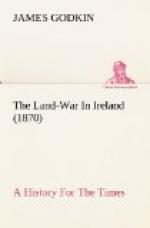These four septs were divided in all places of the four quarters of Ireland, and some of the islands beyond Ireland, as Aran, the land of the Saints, Innisbuffen, Innisturk, Innismain, and Innisclare. These islands, he added, were under the rule of O’Neill, and they were ’very pleasant and fertile, plenty of wood, water, and arable ground, pastures, and fish, and a very temperate air.’ On this description Mr. Froude remarks in a note—’At present they are barren heaps of treeless moors and mountains. They yield nothing but scanty oat crops and potatoes, and though the seas are full of fish as ever, there are no hands to catch them. The change is a singular commentary upon modern improvements.’ There were many branches belonging to the four septs, continues the credulous reporter, who was evidently imposed upon, like many of his countrymen in modern times with better means of information. For example, ’there was the branch of Gogath, the glutton, of which one man would eat half a sheep at a sitting. There was another called the Carrow, a gambler, who generally went about naked, carrying dice and cards, and he would play the hair off his head. Then there was a set of women called Goyng women, blasphemers of God, who ran from country to country, sowing sedition among the people.’[1]
[Footnote 1: Froude’s History, of England, vol. viii. chap. vii.]
Mr. Froude says that this ‘picture of Ireland’ was given by some half Anglicised, half Protestantised Celt, who wrote what he had seen around him, careless of political philosophy, or of fine phrases with which to embellish his diction. But if he was a Celt, I think his description clearly proves that he must have been a Celt of some other country than the one upon whose state he reports. Judging from internal evidence, I should say that he could not be a native; for an Irishman, even though a convert to Anglicanism, and anxious to please his new masters, could scarcely betray so much ignorance of the history of his country, so much bigotry, such a want of candour and discrimination. If Mr. Froude’s great work has any fault, it is his unconscious prejudice against Ireland. He knows as well as anyone the working of the feudal system and the clan system in Scotland in the same age. He knows with what treachery and cruelty murders were perpetrated by chiefs and lairds, pretenders and usurpers—how anarchy, violence, and barbarism reigned in that land; yet, when he is dealing with a similar state of things in Ireland, he uniformly takes it as proof of an incurable national idiosyncrasy, and too often generalises from a few cases. For example, in speaking of Shane O’Neill, who killed his half-brother, Matthew Kelly, Baron of Dungannon, in order to secure the succession for himself, he says—’They manage things strangely in Ireland. The old O’Neill, instead of being irritated, saw in this exploit a proof of commendable energy. He at once took Shane into favour, and, had he been able, would have given him his dead brother’s rights.’




